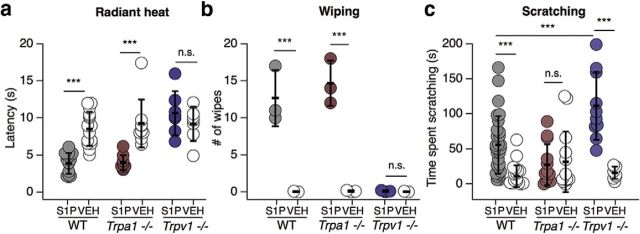Figure 5.
S1P evokes itch and pain via distinct TRP channel-dependent pathways. a, Radiant heat paw withdrawal latencies 20–30 min after injection of 15 μl of 10 μm S1P or 1% methanol-PBS vehicle intradermally into the hindpaw of age-matched WT, Trpa1−/−, and Trpv1−/− mice; p < 0.0001 [one-way ANOVA (F(5,66) = 14.13); n = 7 or more age-matched mice per condition]. Sidak's multiple-comparisons p-values are represented on graph: ***pWT < 0.0001; ***pTrpa1 < 0.0001; pTrpv1 = 0.193. b, Number of wipes in response to intradermal injection of 20 μl of 10 μm S1P or 1% methanol-PBS vehicle in cheek of age-matched WT, Trpa1−/−, and Trpv1−/− mice; p < 0.0001 [one-way ANOVA (F(5,11) = 33.98); n = 3 age-matched mice per condition]. Sidak's multiple-comparisons p-values are represented on graph: ***pWT = 0.0001; ***pTrpa1 < 0.0001; pTrpv1 = 0.99. c, Time spent scratching in response to intradermal injection of 20 μl of 0.2 μm S1P or 0.1% methanol-PBS vehicle in rostral back of age-matched WT, Trpa1−/− and Trpv1−/− mice; p < 0.0001 [one-way ANOVA (F(5,91) = 14.13); n = 8 or more age-matched mice per condition]. Sidak's multiple-comparisons p-values are represented on graph: ***pWT = 0.0002; pTrpa1 = 0.99; ***pTrpv1 < 0.0001; ***pWT S1P vs. Trpv1 S1P = 0.0005. Error bars indicate mean ± SD.

